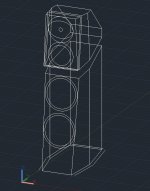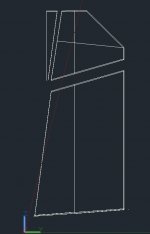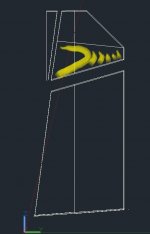Sheeps wool is the best for a sealed box IMO. It has the right amount of dampening characteristics and is linear across most of the frequency range Other materials tend to suck the life out of the sound (fiberglass) or do nothing much to be worth the effort (dacron). If only decreasing the internal reflection is desired, I use thick felt to line the cabinet walls. I've also used grille cloth on smaller mid enclosures to lower Qt significantly without much ill effect.
So sheep's wool is full of life and fibre glass sucks life out in de midrange. Interesting observations, which I unfortunately do not share at all.
To damp the Fs, must the line length have to be 1/4wl?
No, but it is better if it is long enuff that the entire bandwidth of the driver has enuff distance to travel that the lowest frequencies pass thru at least a half-wave of damping while they travel from the driver to the end of the line and back.
I'm looking at with 28hz-40hz Fs.
As a midrange?
dave
as a loudspeaker dominated by mechanical damping sound usually lifeless
Some of the best i have heard are well damped mechanically.
dave
Hello augerpro,
Fighting with the same thing, trying to determine what would be the best midrange cabinet for CAC17 / Satori eventually. I made sketch and will try to do some kind of tapered TL /aperiodic box shape which will be extended to the full depth of speaker. It can be opened at the end and if this will not be good simply to close it. Also it will not have any parallel walls....Damping,...I don't know yet, and there will be no consensus here on diyAudio I think. I checked many threads and there are strong opposite opinions...about bass tuning there is always some agreement, midrange topic is like voodoo....
Fighting with the same thing, trying to determine what would be the best midrange cabinet for CAC17 / Satori eventually. I made sketch and will try to do some kind of tapered TL /aperiodic box shape which will be extended to the full depth of speaker. It can be opened at the end and if this will not be good simply to close it. Also it will not have any parallel walls....Damping,...I don't know yet, and there will be no consensus here on diyAudio I think. I checked many threads and there are strong opposite opinions...about bass tuning there is always some agreement, midrange topic is like voodoo....
Attachments
As a midrange?
dave
The Fs of the drivers I'm looking at fall within 28-40hz. Once in a sealed box, you could maybe add 10-20hz to that for the final Fb.
Well, at not even €10 for a 10mH + 100uF and 6R8 together at my local store, it seems not that expensive to me. And bring the fc up by reducing the volume, values go down in general. But I must confess the acoustic solution is tempting.These can be very expensive, given how large the filter values must be.
Also with damping there is a right amount of it given a set of fixed parameters (enclosure, driver). You change other parameters it can be that a different damping should take place to get the box sounding right again.
Why there are different opinions on this is there are always several possibilities to get a certain response - influenced not only by the crossover.
My personal opinion is that enclosures should not be stuffed in closed boxes. Just a fill with fibers (100% fill) of the preferred sort but no stuffing (stuffing would be 200% or 300% filling with fibers).
However I never experienced current driven loudspeakers (current amplifiers). Here it could be that without dsp correction stuffing of a box is needed to get the Q down enough.
Today mechanical damped loudspeakers are very rare. Most loudspeakers are two way designs with bass reflex. Here too much damping eliminates the reflex function.
I know that well damped loudspeakers can sound articulate and correct but somehow too much like a revealing monitor speaker. If you want to listen to music and have fun less damping is acceptable. So there is some headroom for designing the speaker to your own taste.
Now people who do not build loudspeakers themselves do not have an idea what possibilities the manufacturer had in creating the sound of the box. End users then experiment with cables and positioning the speaker in the room.
Why there are different opinions on this is there are always several possibilities to get a certain response - influenced not only by the crossover.
My personal opinion is that enclosures should not be stuffed in closed boxes. Just a fill with fibers (100% fill) of the preferred sort but no stuffing (stuffing would be 200% or 300% filling with fibers).
However I never experienced current driven loudspeakers (current amplifiers). Here it could be that without dsp correction stuffing of a box is needed to get the Q down enough.
Today mechanical damped loudspeakers are very rare. Most loudspeakers are two way designs with bass reflex. Here too much damping eliminates the reflex function.
I know that well damped loudspeakers can sound articulate and correct but somehow too much like a revealing monitor speaker. If you want to listen to music and have fun less damping is acceptable. So there is some headroom for designing the speaker to your own taste.
Now people who do not build loudspeakers themselves do not have an idea what possibilities the manufacturer had in creating the sound of the box. End users then experiment with cables and positioning the speaker in the room.
Just a fill with fibers (100% fill) of the preferred sort
That is stuffing the box. One can certainly put so much damping in that it starts becoming a solid instead of a damper/
dave
I've done it a few times, most recently on the Bottleships build. It has to be an MAPD style chamber wither a controlled leak between sealed volumes. Northbrook recommended 2:1 volume and a Qts of 0.6, and I've used anything from 1:1 to 2:1.
Usually, I find lightly stuffing the front volume and only lining the rear yields the best results.
Usually, I find lightly stuffing the front volume and only lining the rear yields the best results.
wolf> I don't know what a MAPD is, do you have some links? Sounds like what I am looking for. Were you satisfied with the results?
Midrange TL enclosure will do the trick, but it requires volume larger than the usual closed-box cavity.Very often when using a midrange in a 3-way, Fs impedance correction is required to get the proper behavior of the driver. These can be very expensive, given how large the filter values must be. I'm wondering if there is anything we can do with the box to tame the resonant peak? Something like an aperiodic damper, or? Or possibly Helmholtz arrays?
Try the serial crossover (between woofer and midrange), it is very insensitive of Fs impedance peak.
I once saw a speaker that had a flap of wood swinging by a piano hinge as the "port". It went with a Leak amplifier in an antique store...I never liked too much damping in loudspeakers or using Variovents (controlled damped leakage of the box) as a loudspeaker dominated by mechanical damping sound usually lifeless.
Printed Meta material: https://www.diyaudio.com/community/threads/3d-printed-metamaterials.360739/
The thread also contains a link to a relevant JAES publication.
This is the best way to go IMHO
Yes, light stuffing with sheeps wool yields by far the best compromise for midrange dampening when compared to other materials. Dacron fiberfill just starts acting like a solid and fiberglass / Rockwool slightly adds mass which overdampens the lower mids on down - it can actually lower Fb considerably. That may be favorable with a higher Qts driver, but it kills the liveliness of the lower mids and bass.So sheep's wool is full of life and fibre glass sucks life out in de midrange. Interesting observations, which I unfortunately do not share at all.
Roving (Merino) sheeps wool stuffing has the advantage of having very non directional fibers that reduces the amplitude of the lower resonance more effectively without killing the "musicality" in the lower mids. I dont advocate over stuffing to the point of substantially lowering Qtc, but rather lightly filling the enclosure just enough to have the wool occupy the entire cavity (can't give you exact oz per cu.ft. numbers, but you would have to dampen "to taste"). For a midbass or midrange enclosure, I always use this method, sometimes coupled with a tapered rear chamber with increasing density of stuffinf towards the rear ie like a TL. This usually reduces Fb enough to keep the impedance peak from affecting the HP rolloff linearity, so you dont need to electrically flatten the Fb impedance peak with an LCR trap, which can be expensive in parts. As with a tweeter HP, you would want the HP frequency sufficiently higher than Fs (or Fb) peak to not mess with the slope linearity.
I've experimented a few eons ago with a passive driver occupying the same enclosure as the LF driver wired in series to an L-pad (partially shorting it) to adjust LF dampening, sort of like a passive radiator with a VC to dampen enclosure Fb. With this you can adjust the enclosure to favor the music or your taste. It also aids in speaker placement to control the amount of LF room or boundary gain. For this to work well you will need a "dummy" woofer that is larger than the main active LF driver for the sake of linearity. You can also go to the extent of wiring an inductor, cap or effectively create an LCR to selectively tune the enclosure at specific frequencies and bandwidth (Q).
The first time I tried the above scheme was with a friend's set of Infinity WWMT towers that had 10" woofers in sealed enclosures. He didn't like the loose sloppy bass, so i suggested installing a rear mounted 12" dummy driver with a shorting Lpad to dampen the LF. The trick was to not let the dummy driver act as a PR, creating a BR enclosure, but rather a dampening element to reduce the Fb peak. I ended up using an LC network in series dampened with the Lpad. It worked like a charm and allowed the speakers to be placed closer to the walls or corners without the excess boomy bass peak. The additional benefit of this was you could sufficiently drop the Fb peak while not killing the liveliness of the lower mids from excessive enclosure stuffing.
The first time I tried the above scheme was with a friend's set of Infinity WWMT towers that had 10" woofers in sealed enclosures. He didn't like the loose sloppy bass, so i suggested installing a rear mounted 12" dummy driver with a shorting Lpad to dampen the LF. The trick was to not let the dummy driver act as a PR, creating a BR enclosure, but rather a dampening element to reduce the Fb peak. I ended up using an LC network in series dampened with the Lpad. It worked like a charm and allowed the speakers to be placed closer to the walls or corners without the excess boomy bass peak. The additional benefit of this was you could sufficiently drop the Fb peak while not killing the liveliness of the lower mids from excessive enclosure stuffing.
Btw, what often works quite well instead of a whole set of filter+RLC is only a R in series to the L of the highpass. In best case an air coil with thin wire and the desired R value.
But a midrange-RLC costs a 20$, so mainly of interest for professionals who count every penny…
But a midrange-RLC costs a 20$, so mainly of interest for professionals who count every penny…
- Home
- Loudspeakers
- Multi-Way
- Fs impedance correction with only the box?


